The ABCs of LCAs and EPDs
Recognizing the importance of comprehensive life-cycle analysis studies for roofing and cladding systems, the metal industry has invested substantial resources and effort to provide building teams with key product information to help design and build truly sustainable buildings
![]() Continuing Education
Continuing Education
Use the following learning objectives to focus your study while reading this month’s Continuing Education article.
Learning Objectives - After reading this article, you will be able to:
- Explore the sustainability and durability benefits of metal roofing and wall systems.
- List the information provided in product category rules (PCRs), life-cycle assessments (LCAs), and environmental product declarations (EPDs), and describe how the sustainable building market is driving the need to continue developing them.
- Review extensive metal roof and cladding industry efforts to perform these LCA studies and make this information freely available to the industry.
- Discuss how metal roofing and cladding systems compare to other systems in terms of LCA.
- Identify shortcomings with current LCAs and subsequent EPDs and how they are being addressed.
Sustainable building design is arguably one of the biggest trends in the building and construction industry and is an important consideration in just about any building project going on today.

Photo courtesy of 3A Composites USA/Jamey Price Photography
In order to sustainably retain the strong architectural massing of Uniondale, New York’s Nassau Veteran’s Memorial Coliseum, while giving its facade an entirely new look, an intricate metal design system wraps the 416,000-square-foot coliseum with approximately 4,700 unique aluminum “fins” created with recyclable aluminum composite material.
In fact, Market Research Future predicts the green building market will continue growing at a rate of 17 percent annually through the year 2022, and within the next four years, the market’s collective value will surpass a valuation of $245 billion, up from $158 billion in 2015.
To really appreciate this rate of growth, a look at U.S. Green Building Council statistics reveals a dramatic increase from 296 LEED project certifications back in 2006 to 92,000 registered and certified commercial projects totaling more than 1.8 billion square meters (19.4 billion square feet) in 2017.
Now that green building is fully established, the industry is experiencing an important shift toward incorporating health and well-being into today’s sustainable criteria.
In line with this market demand for building product transparency, building product manufacturers have been busy analyzing the full life-cycle assessment (LCA) of their products, from raw material extraction to recycling/landfill to help building teams make more informed decisions when seeking green products.
Metal Walls and Roofing
Under LCA criteria, the characteristics of metal wall and roofing systems fare quite well with high recycled content, recyclability, durability, and longevity characteristics.
“From a product perspective, metal buildings are good for the environment because they are made from recycled steel, are 100 percent recyclable, and produce a low carbon footprint,” states John Cross, P.E., vice president, American Institute of Steel Construction (AISC), Chicago. “From a performance perspective, metal building panels promote energy efficiency because they are designed to incorporate fiberglass or rigid insulation of varying thicknesses, thus enhancing insulation values. From a construction perspective, offsite fabrication reduces excess material required and construction equipment emissions, and faster cleanup is achieved because metal buildings generate over 50 percent less job site waste than other construction materials.”
Take metal roofs, for example. Their average service life can reach 60 years, which is considerably more than roofing alternatives. In fact, BOMA International reports that the expected life-cycle cost of metal roofs is 30 cents per square foot per year, as compared to 37 cents per square foot for asphalt and 57 cents per square foot for single-ply roofing per year.
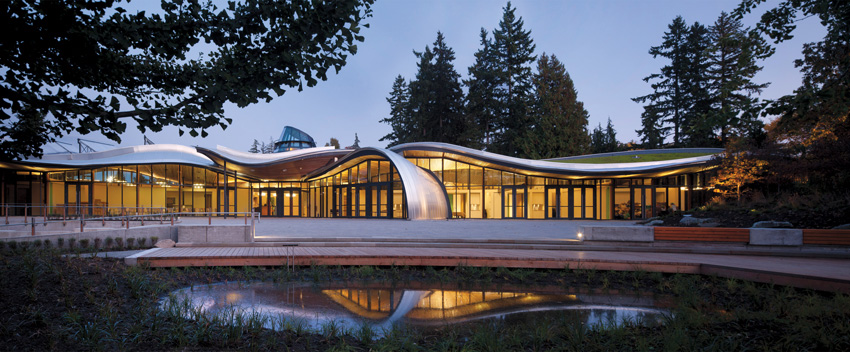
Photo courtesy of 3A Composites USA, Inc.
Meeting International Future Living Institute Living Building Challenge standards, the net-zero VanDusen Botanical Gardens Visitor Centre in Vancouver, British Columbia, features a living roof blending striking aluminum composite panels with traditional wood.
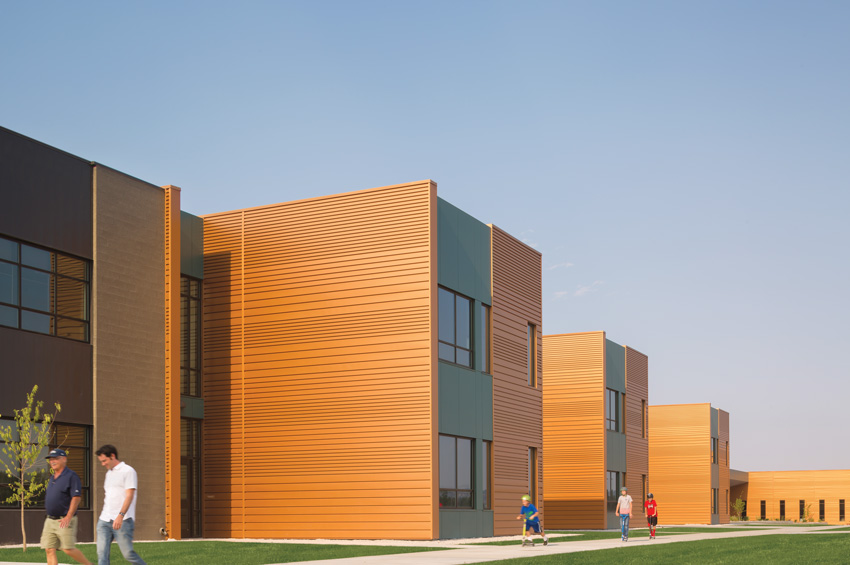
Photo courtesy of Metal Sales/Lara Swimmer
When designing the Medicine Crow Middle School in Billings, Montana, the community was interested in a resilient space that could provide a minimum lifespan of at least 50 years. Sustainable metal wall panels were designed as a durable and aesthetically interesting solution while meeting sustainability and energy goals for the exterior envelope.
Significantly factoring into this are maintenance costs, with owners spending 3.5 percent of total installed costs on maintenance versus 28.5 percent for asphalt roofs and 19 percent for single-ply, according to BOMA.
Furthermore, metal roofs and panels are light weight for easier installation and reduce the structural load on the building, resulting in a lower environmental footprint and building costs.
In an Environmental Building News article, “Cladding: More than Just a Pretty Facade,” Brent Ehrlich, LEED AP BD+C, product and materials specialist, BuildingGreen, points out that metal panels can be anodized to improve corrosion resistance and coated, which enhances durability and resistance to dirt accumulation. “Because metal claddings are lightweight, rainscreen systems that employ them can use smaller clips, resulting in less thermal bridging and better overall thermal performance for the building,” he writes.
As a highly recyclable material, end-of-life metal roofs rarely go to the landfill, as compared to an Environmental Production Agency estimation of 11 million tons of asphalt shingles ending up in landfills every year.
Incidentally, steel can be “multi-cycled” with no loss of material attributes, which makes steel the first and only true cradle-to-cradle building cladding, roofing, and framing material. Furthermore, steel enjoys superior water resource management with a 95 percent water recycling rate—with no external discharges—producing a net consumption of 70 gallons per ton.
Another important point is that metal roof and wall cladding systems are custom-engineered and produced for each building project to exact specifications, which means that the metal and other building details are fully optimized (i.e., not wasted) during fabrication and construction.
Furthermore, metal building providers typically have multiple production facilities around the country, making regionally sourced materials frequently available.
LCAs and EPDs
As building teams work to navigate the challenging process of assessing the true sustainable attributes of building products and systems, LCAs and environmental product declarations (EPDs) are becoming indispensable tools.
Unlike a simplified, one-attribute approach to sustainability, LCAs are designed to take a much broader look at the environmental impacts produced by a product’s full life cycle. This includes the utilization of a recognized global methodology with a transparent, holistic, and balanced approach to product evaluation; an inventory of all energy/material inputs and environmental releases; the potential impacts associated with all these inputs and releases; and an interpretation of these results.
Included in this LCA is information on sourcing of raw materials, transporting the raw materials to the manufacturing plant, the manufacturing process, shipping and transportation, construction and installation, the product’s use and maintenance, and recycling, disposal, or product repurposing.
Manufacturers are then taking these comprehensive, third-party-verified LCAs and turning them into EPD labels for their products.
“The EPD provides a summary of the environmental impacts and attributes of a product that the consumer can use to gain a better understanding of a product and/or system,” explains Gary Jakubcin, president/general manager, B&G Jakubcin & Associates LLC, Pickerington, Ohio.
Along these lines, John Jewell, senior consultant, thinkstep, Boston, adds, “EPDs are communication tools that bring complex LCAs into a more user-friendly format by streamlining the information presented and enforcing as much consistency as possible.”
Putting things into perspective, Roderick Bates, LEED AP BD+C, principal, KieranTimberlake, Philadelphia, explains that for the designer, there are a lot of factors to consider when selecting a product, including cost, appearance, availability, and lead time, in addition to environmental performance. “EPDs, along with LCA software, are critical components of this selection criteria, and by making the data readily accessible, this ensures the information is available at the time material selection decisions are actually being made.”

Photo courtesy of RHEINZINK/Mark-Kempf-Photography
The University of Iowa Visual Arts Building presents an industrial aesthetic with 38,000 square feet of titanium zinc cladding and poured-in-place concrete walls. The main entrances on the southwestern and southeastern sides are covered in 1.5-millimeter perforated stainless-steel panels, thereby creating a rainscreen system.
Similarly, in an AISC continuing education unit titled “Sustainability and Structural Steel, A Closer Look,” Kevin Nasello, AIA, LEED AP BD+C, senior associate and director of sustainability, CetraRuddy, New York, states, “As architects and designers, we believe that it is our professional responsibility to minimize the impact of the structures we design and build. Analysis of the embodied energy and other environmental impacts associated with each material is an imperative first step to a sustainable building design.”
Taking a step back, the first thing that typically happens before EPDs can be developed is industry groups create a set of product category rules (PCRs). This is a standardized set of rules for the collection and reporting of environmentally relevant information within that specific product type.
Per the International Standard Organization (ISO) Standard 1402, manufacturers must use these PCRs for assembling and measuring environmental data. The PCRs are used to develop and verify the product LCA, and the full report is expert certified, signed, and posted with an EPD program operator.
“The PCR is a ‘road-map’ document that outlines how an LCA must be done and what it should include,” explains Jakubcin. “It is this process that allows a truer ‘apple-to-apple’ comparison of like products.”
In terms of why building teams are prioritizing EPDs in their projects, the American Chemistry Council in a Green Building Solutions blog titled “What is a EPD” explains:
- EPDs are becoming more available and are increasingly being used to address a growing market demand for quantified environmental information.
- The U.S. Environmental Protection Agency recognizes EPDs as a means of detailing the environmental impacts of materials in buildings.
- EPDs make decisions and judgments more informed and defensible for code officials making an approval determination.
For building products seeking green rating certifications, LEED v4 requires EPDs for some material credits and programs like WELL and the Living Building Challenge are forcing project teams to critically analyze the chemicals in the products and materials they are specifying, essentially obligating them to select healthier alternatives.
Metal Roof and Cladding LCA Research
Taking the industry’s need for detailed, transparent life-cycle product information quite seriously, a few years ago, both MCA and the Metal Building Manufacturers Association commissioned third-party experts to analyze metal building products and systems and comparable materials.
MCA’s initial study, “Life-Cycle Assessment of Metal Construction Association Production Processes, Metal Roof and Wall Panel Products,” conducted by thinkstep (previously PE International) reported that raw materials acquisition and processing were the primary variables driving the environmental profile of these products.
The main findings emerging from the study, conducted in accordance with ISO 14040/44 and 21930 standards, reported that the appropriate treatment of waste material can significantly reduce a product’s environmental profile. At the same time, upstream metal production accounts for a good percentage of the environmental footprint. Another noted finding was that transporting the goods and materials is minor within the context of the overall manufacturing process.
As for the MBMA study, Walter P. Moore and Associates was brought in to compare the environmental impacts of a metal building system to other forms of construction as calculated by Athena Institute Impact Estimator software.
The industry-accepted software were selected for its ability to model more than 1,200 structural and envelope assembly combinations, thereby enabling comparison between multiple design options.
In this case, environmental data was reported for each systems’ global warming potential, ozone depletion potential, acidification potential, smog potential, nonrenewable energy, and eutrophication potential. A total of 30 buildings from three different areas of the country were analyzed.
Ultimately, the results were quite compelling, as metal buildings showed lower environmental impacts in all six metrics when comparing structural and envelope materials to load-bearing masonry walls, concrete, tilt-up, and steel-framed construction of the same building footprint and functional equivalence. The report results concluded that for the types of building where metal buildings are typically most economical, they generally perform better in LCA analyses and produce the least embodied building material impact.

Photo courtesy of CENTRIA/Joe Brennan Phalanx Studios
To maintain the authenticity of the original Speed Art Museum in Louisville, Kentucky, three shifted volumes sheathed in fritted glass and folded aluminum panels were stacked along the 60,000-square-foot north pavilion. The design also includes an aluminum composite wall panel system, custom corrugated expanded aluminum panel system with a custom pattern, a metal wrap insulated-core metal wall system, corrugated screen wall with aluminum corrugated wall panels, and aluminum fixed louvers.
Updating the availability of this valuable life-cycle data, MCA commissioned yet another study last year, “Life Cycle Assessment of Roof and Wall Envelope Assemblies,” conducted by thinkstep and reviewed by three independent, third-party experts.
The study’s primary goals included the following:
- Understanding the magnitude of the selected potential environmental impacts per life-cycle stage.
- Understanding how assemblies based on MCA products compare to assemblies based on competitive exterior cladding products.
- Using LCA results to inform a marketing strategy to help differentiate metal products with lower environmental profiles.
- Creating a road map for MCA to continuously improve the sustainable performance of wall and roof panels.
In order to evaluate and compare roof and wall envelopes, KieranTimberlake was commissioned to design functionally equivalent roof and wall assemblies, and thinkstep evaluated the environmental performance of the assemblies for cradle-to-grave parameters, including raw materials production, component manufacturing, transport to job site, installation, maintenance and replacement, deconstruction, and disposal.
In place of EPD information, which is developed based on PCRs that contain a variety of different assumptions, MCA chose to have thinkstep develop an LCA model created with GaBi software, which provides the life-cycle inventory data for several of the raw and process materials obtained from an upstream system and offers more consistency for the materials evaluated in the study.
The life cycle for the analyzed systems was broken down into five stages:
- Product: production of materials and/or components used in each assembly
- Construction process: transport of materials to the job site and erection of the assembly at the job site
- Use: maintenance, including repainting and replacement of components, as they reach the end of their respective reference service lives
- End of life: demolition of the assembly at the end of the building service life (60 years), as well as recycling, incineration, or landfilling of the assembly materials
- Reuse/recovery/recycling potential for recycled materials
As compared to MCA’s 2012 study, this time, a total of eight inventory/impact categories were applied. To better understand the characteristics of each of the categories, the following definitions are provided.
Global warming potential is a measure of greenhouse gas emissions, such as CO2 and methane. It is these emissions that are causing an increase in the absorption of radiation emitted by the planet, thereby exacerbating the natural greenhouse effect. It is generally assumed that this is causing adverse impacts on ecosystem health, human health, and material welfare.
The next category, eutrophication potential, focused on nitrogen and phosphorus which, in high levels, are suspected to cause an undesirable shift in species composition and elevated biomass production in both aquatic and terrestrial ecosystems.
Acidification potential is defined as the measure of emissions that cause acidifying effects to the environment. This is a molecule’s capacity to increase the hydrogen ion (H+) concentration in the presence of water, which then decreases the pH value. Potential adverse effects include fish mortality, forest decline, and building material deterioration.
In the category of smog formation potential, ozone (O3) and other smog-related chemicals are produced when volatile organic compounds (VOCs) and carbon monoxide are exposed to nitrogen oxides under the influence of UV light. Ground-level ozone is suspected to cause harm to human health and ecosystems and may also damage crops.
The next level of suspected ozone damage, ozone depletion potential is the measure of air emissions that contribute to the depletion of the stratospheric ozone layer. The depletion of the ozone allows higher levels of UVB ultraviolet rays to penetrate the earth’s surface and cause detrimental effects on people and plants.
Abiotic resource depletion is the consumption of nonrenewable resources, which decreases the future availability of these resources.
Primary energy demand accesses the total amount of primary energy extracted from the earth, expressed in energy demand from nonrenewable resources and energy demand from renewable resources. Efficiencies in energy conversion are also taken into account.
Finally, water consumption measures the net intake and release of fresh water across the life of the product system.
The Rundown on Roofing Systems
Within the study’s extensive LCA breakdown of roofing systems, the following systems were analyzed and compared: PVC membranes, TPO membranes, architectural low-slope metal roof panels, asphalt shingles, and architectural steep-slope metal roof panels.
Starting with a PVC membrane, the initial raw material production of the panels was found to be the main environmental contributor, and the assembly’s disposal ranks high in eutrophication potential due to disposal of the plastic to landfill and its connection to phosphorous emissions to water from leachate treatment.
With a TPO membrane, because the assembly design and material inputs are very similar a PVC assembly with the exception of the membrane polymer, the potential impacts were similar.
In analyzing the architectural low-slope metal roof panel, the 60-year service life for both the metal deck and metal roof panels mitigate the assembly’s environmental impact, which stands out in comparison to a 30-year service life for PVC and TPO membranes. And unlike the environmental burden created by the plastic contained in PVC and TPO assemblies, the ability to recycle the majority of the steel produces an end-of-life credit. In addition, the regrinding the asphalt underlayment to aggregate filler is considered valuable as well.
With asphalt shingles, the LCA impacts primarily stem from raw material production and maintenance as the shingles and asphalt felt sheet need to be replaced halfway through the 60-year building life.
Because the shingles are generally not sourced locally, the nitrogen oxide and sulfur dioxide tailpipe emissions from transport vehicles factor in more significantly. Additional emissions are calculated for wood disposal to the landfill.
Like low-slope metal, architectural steep-slope metal roof panel can last 60 years. In most categories, steep-slope metal’s environmental impacts are lower than those of asphalt shingles.
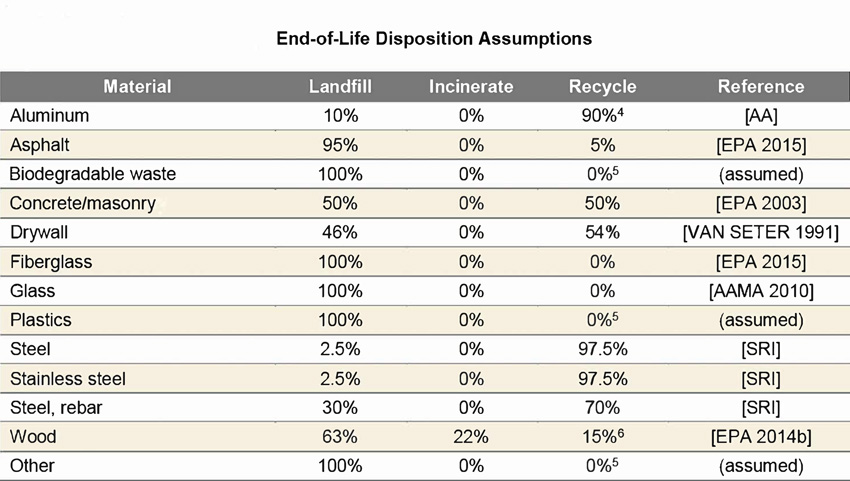
Image courtesy of Metal Construction Association
As compiled in the Metal Construction Association’s “Life-Cycle Assessment of Roof and Wall Envelope Assemblies,” metal roofing and cladding systems offer the highest recyclability percentages as compared to other materials.
Overall, Trisha Montalbo, senior consultant, thinkstep, Boston, reports, “The metal roofing system was shown to use less nonrenewable energy resources, like crude oil, across its life cycle than all the other systems. Compared to asphalt shingles, the metal roofing system also has lower energy consumption and less potentially harmful emissions across its life cycle.”
Generally speaking, KieranTimberlake’s Bates points out that longevity of service life and visual appearance over time are arguments in favor of metal roofs over PVC and TPO. He adds that compared to asphalt shingles, metal roofing absorbs less thermal energy from sunlight, thereby reducing cooling loads.
Wall Assembly Comparisons
In the wall assembly portion of the study, the following systems were analyzed: brick veneer, exterior insulation finishing systems, architectural precast concrete, tilt-up concrete panels, industrial insulated metal panels, architectural insulated metal panels, metal composite material panels, and metal wall panels.
Honing in on the metal wall systems, once again a 60-year service life serves an environmental advantage for these assemblies. With industrial insulated metal panels, 60 percent of the assembly is made from steel and the rest is a gypsum wallboard backing, which has a low impact-to-mass ratio for most categories. Recycling the steel makes a significant contribution to reducing the assembly’s environmental impact and is particularly significant when compared to precast concrete.
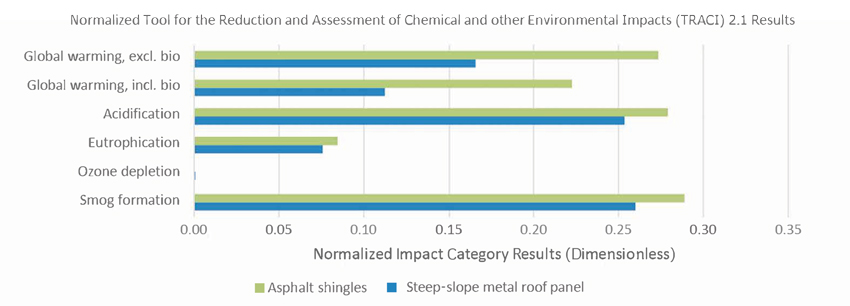
Image courtesy of Metal Construction Association
Within MCA’s extensive roofing and cladding LCA study, steep-slope roof assemblies leave a smaller environmental footprint in all categories when compared to asphalt roofing systems.
Made from a similar material composition, architectural insulated metal panels therefore produce a similar environmental evaluation. Overall, the impacts associated with an architectural insulated metal panel assembly are generally lower than those associated with the tilt-up concrete assembly. In the realm of global warming potential, excluding biogenic carbon, the metal panels fare better than precast concrete assemblies. For eutrophication potential, the panels are the second lowest, in comparison to all the wall systems which were studied.
For metal composite material panels, end-of-life credit is given for the aluminum cladding and gypsum wallboard, and with metal wall panels, for the steel cladding and gypsum wallboard. Overall, the metal wall panels offer a lower environmental burden than the tilt-up concrete assemblies. When factoring in end-of-life credits, this slightly increases the preference for the metal wall panel over the EIFS assembly.
“The excellent recyclability of steel is one of its strongest environmental attributes,” confirms Montalbo. “Additionally, with respect to carbon footprint and demand for nonrenewable energy resources, most of the metal wall assemblies were preferable to the concrete-based assemblies.”
Although both the metal composite material (MCM) and metal wall panels have higher ozone-depleting emission potential than other cladding materials, this concern is normalized when compared to the average statistical environmental burdens in the United States.
Applying LCA Data
Offering some overall perspective on the significance of this study, Philip S. Moser, P.E., senior project manager, Simpson Gumpertz & Heger, Waltham, Massachusetts, is pleased the industry invested in harvesting this valuable LCA information.
“In-depth and non-biased LCA studies like this are important because they advance the state of knowledge in the industry,” he states. “I am glad that the team responsible for study had a high level of commitment to making the study as accurate, credible, and transparent as possible.”
Unfortunately, this isn’t always the case, as Moser references Ehrlich’s Environmental Building News article on cladding, which laments the inconsistency of past cladding industry LCA studies. Here, Ehrlich cites one vinyl siding study that ranked vinyl is the most environmentally responsible siding choice, outperforming brick, fiber cement, stucco, cedar, and EIFS on most metrics. Meanwhile, a cedar lumber industry study shows cedar outperforming vinyl, brick, and fiber cement, and another brick industry study presented brick as outperforming block masonry, fiber cement, vinyl, and EIFS.
The article then quotes LCA expert Rob Sianchuk, director of business development, Coldstream Consulting, as saying, “For LCA practitioners, one of the most frustrating things is stereotyping materials” by over-generalizing based on LCAs.
“With that controversy as a backdrop, it was particularly important that the MCA study is non-biased and credible,” Moser states.
Stressing the importance of accurate LCAs, thinkstep’s Jewell points out that they are very useful to paint the whole picture as opposed to guessing what factors are most important to support a more ecofriendly environment. Furthermore, by bringing the full picture to light, this prevents the shifting of environmental burdens from one part of the life cycle to another. For this particular study, a framework is provided to enable comparability of complex scenarios.
“Many designers don’t have the time or resources for a comprehensive options comparison of the scale presented in the study,” notes Bates. “By providing this analysis as a resource, the MCA is enabling the proliferation of important environmental performance data to an audience that, while interested, wouldn’t otherwise have the LCA data upon which to act.”
That said, to optimally utilize this data, Moser recommends carefully reviewing the details of the assemblies that were studied. “Because preferences for assembly makeup vary by region, building use, budget, and designer preferences, it is important to verify that the assemblies that were studied are representative of those that are being considered on a project before attempting to make design decisions based on the data provided in the study.”
Meanwhile, Bates believes that the information in the study can best be leveraged early in the design phase when deciding upon the core building components. This approach can help point the designers toward a particular construction typology that is most likely to satisfy their sustainability objectives while meeting the other project requirements.
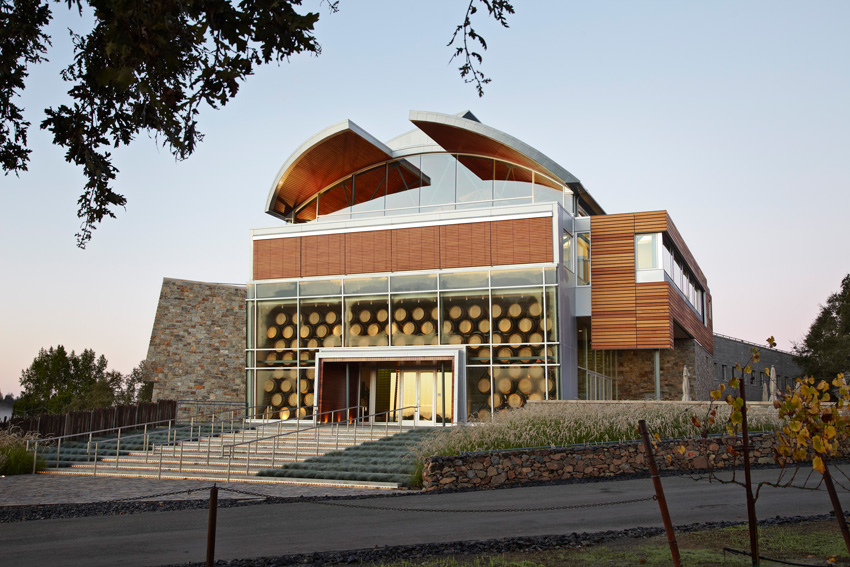
Photo courtesy of RHEINZINK
Emulating a wine barrel, the administrative building for the Williams Selyem Winery in Sonoma County, California, incorporates a curved, barrel-vaulted roof topped with stepped zinc panels.
But before this can happen, building teams must incorporate sustainability performance into their design and purchasing decisions. “Technical requirements, aesthetics, and price will always be important decision criteria, but this study now enables carbon footprint, energy use, water demand, and other environmental metrics to also be included,” Montalbo says.
In addition to benefitting building owners, designers, and contractors, Jakubcin points out that studies like these are also quite useful for product manufacturers, as they provide an opportunity to identify the environmental burdens associated with the entire life-cycle stage of producing their product. “Once these environmental items are identified, the organization can develop programs to reduce the environmental burdens that they feel are important to their company goals,” he says.
Along these lines, the study itself points out that materials account for the majority of the environmental burden associated with each assembly, so addressing the types of materials and amounts used can potentially make the largest impact on reducing the product’s environmental profile.
The report also cites indirect energy consumption as a major factor driving products’ environmental burden. “Therefore, a better way to reduce cradle-to-grave impact may be to add insulating material to limit use-stage energy consumption,” the study recommends.
Where To Go From Here
While LCAs have come a long way in harvesting and assessing extensive life-cycle data, there is more to be done in performing, fine-tuning, and presenting these analyses.
For example, Moser points out that while LCAs and EPDs are a very good way to assess a product’s sustainable attributes, they can be complicated to understand.
“Material selection has never been a quick and easy process, but with all the additional requirements, certifications, and health concerns, it is quickly becoming an almost impossible task for architects and developers to be sure they are selecting the best of the best,” agrees Ian Johnson, a green building consultant with the Cambridge, Massachusetts-based Signature Sustainability in a blog titled “Healthy Building Materials Research.”
“It seems at this point, understanding building product hazards and sustainability criteria could be a university major all in itself,” he adds.
And while the information is valuable, Bates asserts that it isn’t easy to utilize the data directly for an architectural design. “An EPD, as a standalone item, is challenging to make relevant to a particular design, much less to compare across different design options of complex assemblies, each comprising of multiple products,” he says.
Another shortcoming with LCAs is that they rely on broad assumptions about the longevity of materials and assemblies.
“Experience has shown that the longevity of any given building envelope assembly can vary widely, depending on the quality of the project-specific construction details and other factors,” explains Moser. “For example, building envelope assemblies with inferior flashing details or whose attachments are prone to corrosion, may fail, and require replacement prematurely.”
Consequently, he says that the best way to reduce environmental impacts is to design the details to promote the overall longevity of the selected roof/wall envelope assemblies and ensure that all components have compatible life expectancies.
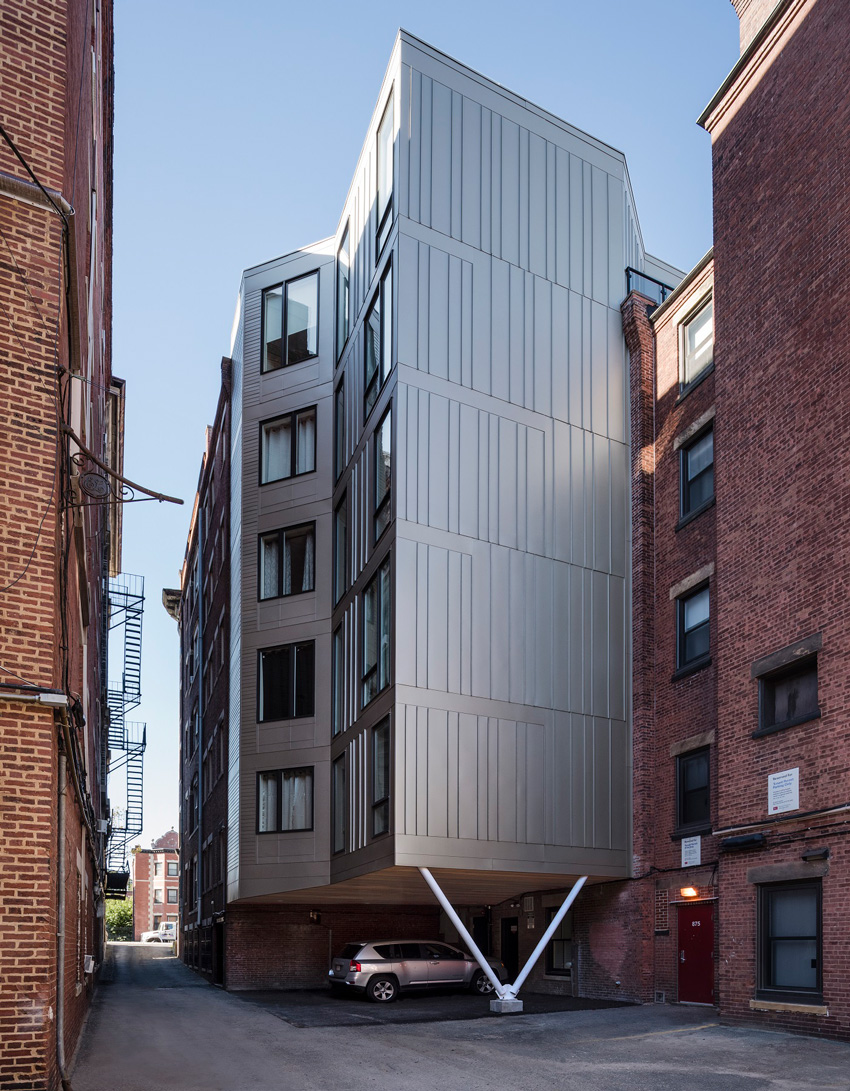
Photo courtesy of Revere Copper Products, Inc./Anton Grassl Photography
To preserve the historical character of Boston’s Residences at 877 Beacon Street in Boston, in addition to lending durability, beauty, and flexibility around curves, copper was selected to clad the front of the building. On the back side, a coil sheet metal was used to create a dynamic facade that expresses the building’s geometry, floor levels, and to break up the massive addition. The metal panel skin introduces a subtle champagne palette to balance the neighboring red brick facades.
Designers should also be aware that a building envelope assembly’s operational energy use—and associated environmental impacts—are often not included in LCA studies and EPDs due to the difficulty in calculating this data and the fact that it can vary significantly across different building types and climates.
“This remains a challenge because accounting for building energy use requires either defining a detailed standard scenario, which will inherently not be able to represent the diversity of buildings and climates that exist, or performing a project-specific LCA,” explains Moser.
Jewell agrees, adding that LCAs and EPDs struggle to provide impact assessment results that are specific to a certain location, which is one of the reasons why LCA, by design, calculates potential environmental impacts rather than accurate predictions.
As for the harvesting of information required for an LCA, product manufacturers are forced to rely on secondary data from suppliers and other members of the life-cycle chain. Although the current LCA process is still considered one of the best ways to analyze the full life-cycle performance of a product, Jakubcin points out that the data from secondary suppliers may be outdated and could introduce some uncertainty into these studies.
Another limitation of LCAs and corresponding EPDs is that they don’t address toxicity, human health, or biodiversity very well, as these impact-assessment methods are still in their infancy, according to Jewell. And while life-cycle costing and social LCA have made great progress in recent years, the social-economic impacts related to sourcing choices have yet to be included.
Furthermore, PCRs are not yet available for all products and are often not consistent enough to guarantee comparability with other EPDs.
“PCRs fail to serve the specifier and the end user when the product category is defined too narrowly (i.e., based on a particular technology) rather being written around a generic product function,” says Moser.
At the same time, Jewell points out that synchronization efforts are underway as stakeholders are learning which constraints are most important to establish for each product type.
“Efforts to harmonize PCRs will ensure better consistency and comparability of EPDs moving forward,” agrees Jewell’s thinkstep colleague Susan Fredholm Murphy, director of consulting and innovation. “This will then enable purchasers to make more informed choices when selecting which product to buy.”
Moser also acknowledges that some program operators have standardized the “part A” of a PCR that is common to all building materials across all construction products but stressed the importance of generic PCRs, in lieu of PCRs written around a specific product, to promote consistency and more accurate comparisons between products.
The Road Ahead
The upshot is that while LCAs and EPDs are becoming continuously advanced over time, there is still a lot of room for improvement.
While today’s designers are typically looking to “check the box” with EPDs, Jewell anticipates that these expectations will change over time as the building industry matures and becomes savvier when it comes to sustainable selections.

Photo courtesy of CENTRIA
Insulated metal panels helped the new Clifford S. Bartholomew Building at William Allen High School in Allentown, Pennsylvania, achieve LEED Gold certification.
“Data and transparency are fundamental to making any kind of an informed decision about a product design, manufacturing process, or building design,” stresses Moser, and accurate, good-quality LCAs are a key part of this equation.
With the development of more sophisticated LCA data and EPDs, this will also enable LCA studies and EPDs of entire assemblies and full building analyses.
Furthermore, a greater integration of EPD data into LCA analysis tools will ultimately enable designers to understand the environmental impact of their specific material selections in real-time, says Bates.
Summing up the key role that LCAs and EPDs play in the sustainable building movement, Fredholm Murphy concludes, “As the world continues to value and promote greater transparency, LCA data will become an increasingly important tool in measuring and disclosing environmental impacts.”

|
The Metal Construction Association brings together a diverse industry for the purpose of expanding the use of metal in construction through marketing, research, technology, and education. MCA member companies gain tremendous benefit from association activities that focus on research, codes and standards, market development, and technical programs. www.metalconstruction.org |
